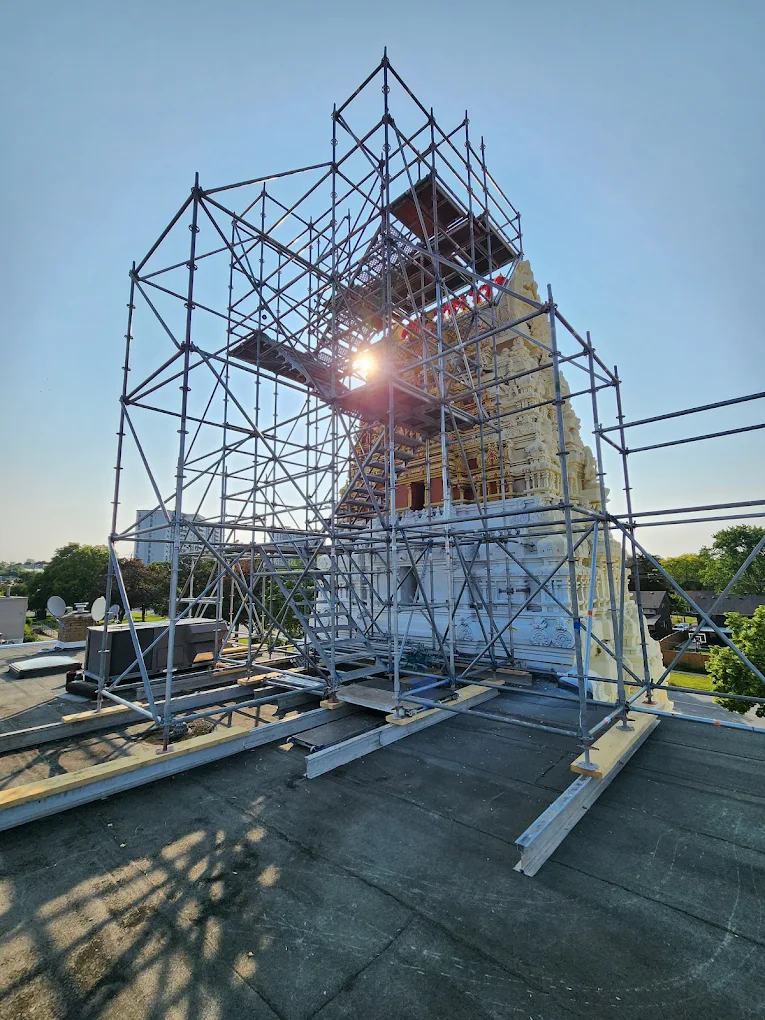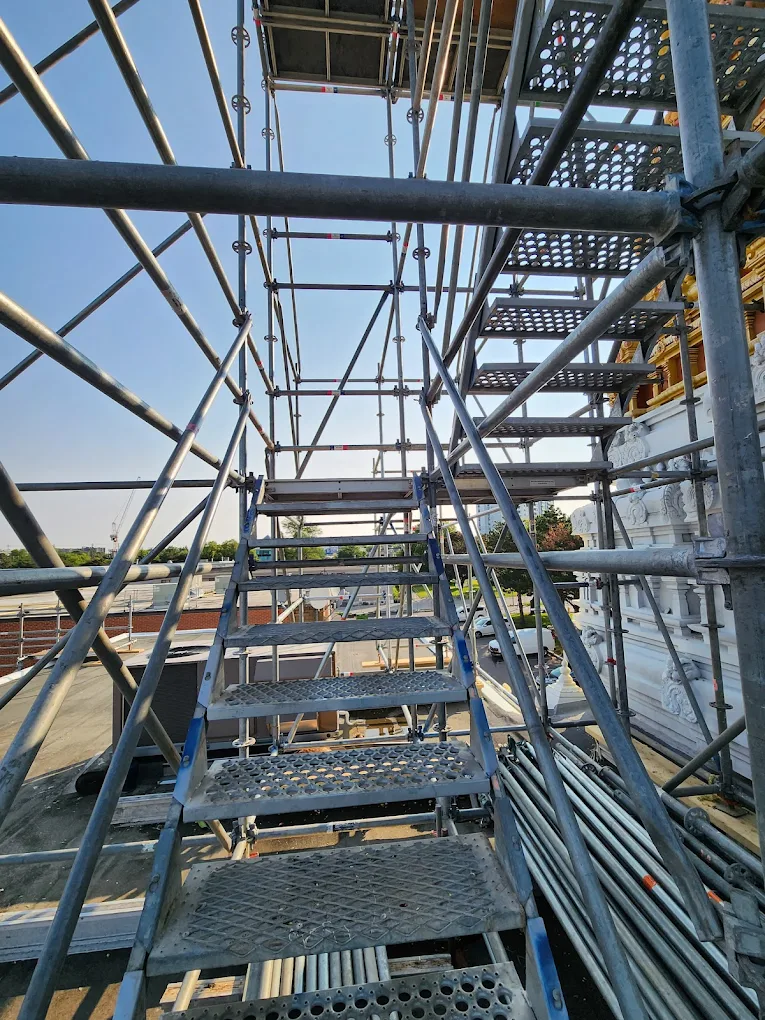A professional's guide to navigating scaffolding regulations for a compliant and successful project.
Building Toronto Safely: The Critical Role of Scaffolding Compliance
For constructors and project managers shaping Toronto's skyline, ensuring worker safety is the highest priority. Central to this is the compliant use of scaffolding. Adhering to regulations isn't just a bureaucratic step; it's a fundamental part of professional construction management.

The stakes are high. Falls from heights are a leading cause of fatalities in Ontario's construction sector, accounting for over 40% of all construction deaths from 2009 to 2024. This stark reality drives the stringent, multi-layered system of provincial laws and municipal bylaws. This guide demystifies those regulations for a safe and compliant worksite.
The Regulatory Framework: Ontario's Core Scaffolding Laws
Scaffolding safety in Ontario is governed by a tiered system of legislation and standards. Understanding this hierarchy is the first step toward comprehensive compliance.
1. The Occupational Health and Safety Act (OHSA)
The OHSA is the foundation of all workplace safety law in the province. It establishes the "Internal Responsibility System," where safety is a shared, non-delegable duty for everyone on a project. It also provides the legal definition of a "Competent Person". According to the Act, this is an individual who:
- Is qualified because of knowledge, training, and experience to organize the work and its performance;
- Is familiar with the OHSA and applicable regulations; and
- Has knowledge of any potential or actual danger to health or safety in the workplace.
2. Ontario Regulation 213/91 for Construction Projects
This is the specific legal code for construction sites. For scaffolding, Sections 126 through 136.0.1 are the critical text, providing legally binding rules for everything from load capacities and stability to fall protection and access.
3. National Standards (CSA Group)
While the OHSA provides the law, standards bodies like the CSA Group provide the technical guidance on how to comply. The key document, CAN/CSA-S269.2 (Access Scaffolding for Construction Purposes), gives engineers and supervisors the specific technical criteria needed to meet legal requirements, such as the exact force a guardrail must be able to resist.
Navigating Toronto's Municipal Requirements
Provincial compliance is only half the battle. Erecting scaffolding in Toronto's dense urban environment introduces a critical layer of municipal rules that can significantly impact project timelines and budgets.
The Street Occupation Permit: A Critical First Step
This permit is mandatory whenever any part of your project, including scaffolding or hoarding, occupies a public right-of-way like a sidewalk or road. The application process is complex and requires the following:
For a comprehensive breakdown, check out our full Toronto Scaffolding Permit Guide.
- Detailed, to-scale plans in metric showing the precise location and dimensions of the occupation.
- A certificate of general liability insurance for no less than $2 million, naming the City of Toronto as an additional insured.
- Payment of a multi-faceted fee structure, which includes a 25% surcharge for projects in a designated "Construction Hub."
- Lead times for approval can be several weeks, so early application is essential to avoid derailing project schedules.
Hoarding and Other Bylaws
The permit process is also linked to requirements for construction hoarding to protect the public. Additionally, projects must adhere to other municipal bylaws, such as Chapter 591 (Noise Control), which restricts construction hours.
Anatomy of a Compliant Scaffold
Explore the non-negotiable technical specifications for a safe scaffold system. Use the tabs below for details.
Foundations, Stability, and Load Capacity
Safety begins from the ground up. A scaffold is only as stable as its foundation.
- Foundations: Scaffolds must be erected on sound, rigid footings or sills capable of supporting at least twice the maximum load without settlement or deformation.
- Load Capacity: The structure must resist at least four times the maximum likely load without overturning.
- Stability & Tie-Ins: A free-standing scaffold's height must not exceed a 3:1 ratio with its smallest base dimension. If it does, it must be securely tied into the building, typically at vertical intervals of 4.57 m (15 ft).
Fall Protection: Guardrails and PFAS
The regulations prioritize collective systems that protect all workers.
- Guardrails: Mandatory on any platform from which a worker could fall 2.4 m (8 ft) or more. A compliant system includes a top rail, a mid-rail, and a toeboard to prevent materials from falling.
- Personal Fall Arrest Systems (PFAS): If guardrails aren't feasible, workers must use a PFAS. Critically, the system must be connected to an adequate fixed support that is independent of the scaffold structure itself.
Access, Egress, and Work Platforms
Safe movement onto, off of, and upon the scaffold is heavily regulated.
- Safe Access: The only approved methods are ladders, stairways, or ramps. Climbing the cross-bracing is strictly prohibited.
- Ladder Requirements: Access ladders must be secured and extend at least 900 mm (approx. 3 ft) above the landing platform.
- Work Platforms: Must be fully decked, at least 460 mm (18 in) wide, and have planks secured with a minimum overhang of 150 mm (6 in) and a maximum of 300 mm (12 in).
When is an Engineer's Design Required?
O. Reg. 213/91 specifies clear height triggers that mandate the involvement of a Professional Engineer (P.Eng.) to design the scaffold. This is a critical compliance point with major implications for liability and project timelines.
On-Site Responsibility and Procedures
A perfectly designed scaffold can be rendered unsafe by improper use. The OHSA's chain of responsibility ensures diligence at every level.

The Chain of Responsibility
The law outlines distinct duties for the Constructor (overall site responsibility), the Supervisor (crew and work area responsibility), and the Worker. A constructor retains ultimate responsibility for the safety of a subcontractor's workers and cannot delegate this duty.
Mandatory Training and Inspections
- Working at Heights (WAH): Any worker who may use a fall protection system must complete a Ministry-approved WAH training program. This is a non-negotiable legal requirement.
- Inspections: A competent person must inspect the scaffold before each work shift and after any event that could affect its stability. A tag system; Green (Safe for Use), Yellow (Use with Caution), Red (Unsafe for Use); is a best practice for communicating its status.
The Consequences of Non-Compliance
Scaffolding regulations are actively enforced. Violations can lead to immediate project shutdowns, severe financial penalties, and even imprisonment for individuals.
Enforcement and Penalties
Ministry of Labour inspectors have the authority to issue a "stop work" order, which halts work immediately. The financial impact of such a shutdown often exceeds the fine itself. Under the Provincial Offences Act, a conviction can lead to substantial penalties:
- Corporations: Up to $2,000,000
- Directors & Officers: Up to $1,500,000 and/or 12 months imprisonment
- Supervisors/Other Persons: Up to $500,000 and/or 12 months imprisonment
Conclusion: Partnering for a Compliant Worksite
Navigating Toronto's intricate scaffolding regulations is a formidable task. The risks of non-compliance are profound, encompassing the tragic human cost of accidents and significant corporate and personal liability.
In this high-stakes environment, expertise is a necessity. Choosing a knowledgeable scaffolding provider is a critical risk-mitigation strategy. It ensures that the equipment, erection plan, and on-site procedures meet and exceed all regulatory standards, safeguarding workers and protecting your project from costly delays and legal jeopardy.
Contact the experts at PEAK Scaffolding today to ensure your next project is safe, compliant, and successful from the ground up.

